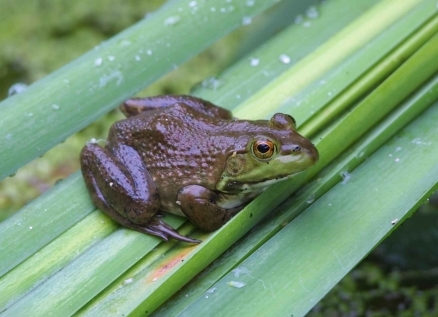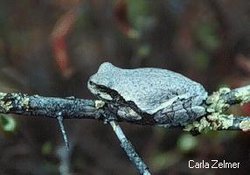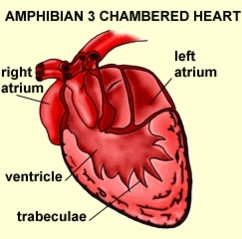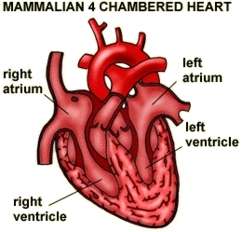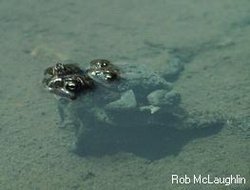Amphibian morphology and reproduction
| Topics: |
Skin
An amphibian's very thin skin isn't covered by fur, feathers, or scales. This makes them vulnerable to dessication and abrupt temperature change, but also offers several advantages. Amphibians can breathe through the entire surface of their bodies. In the case of the lungless salamanders (Plethodontidae), gas exchange through the skin alone provides sufficient oxygen.
Water is also absorbed through an amphibian's skin making drinking unnecessary. Even in areas where open or running water is scarce, an amphibian's skin can absorb moisture from damp soil. Aquatic species would absorb too much water were it not constantly being expelled by their kidneys.
Amphibians display a startling variety of colour which results from different combinations of pigments within their skins. These patterns of colouration are usually designed to provide some form of defense from predators.
In the case of the grey tree frog (Hyla versicolor), colour is used to mimic the bark of lichen-covered trees, effectively hiding it from hungry eyes. By contrast, the poison dart frogs of South America use colour to attract attention and convey a message of warning: "eat me and die!" Similarly, the red eft of the red spotted newt (Notophthalmus viridescens) is named for its conspicuous colour which warns potential predators of the poison it can secrete from glands in its skin.
In the amphibian world, poison or "granular" glands are not the exception, but the rule. Nearly all amphibians can secrete toxins from their skins but most are only mildly poisonous. However, if you handle an American toad roughly, and then touch your lips, you may experience numbness for hours; eat the toad and you will feel thoroughly ill!
The mucous-producing glands in an amphibian's skin are what give this group their slimy reputation, but they also serve a very important purpose. The mucous moistens the skin, optimizing oxygen absorption and providing a thin layer of protection.
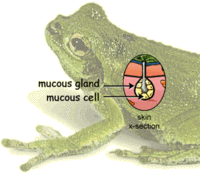 Amphibian mucous-gland. (Source: Canada's Aquatic Environment)
Amphibian mucous-gland. (Source: Canada's Aquatic Environment) In some drier areas, a thin mucous layer isn't enough protection.
Phyllomedusa sauvagei is a large South American tree frog which spends much of its time in tree tops where the wind and heat can cause rapid water loss from evaporation. When P. sauvagei settles into a resting pose, special glands in its skin secrete a waxy substance which the frog then rubs all over its body. When dry, the waxy coat provides enough waterproofing to lower the frog's rate of water loss close to that of a desert iguana!
In addition to lubricating and protecting the skin, glands can function in communication. For example, "hedonic" glands produce pheromones used in courtship. The use of chemical signals is particularly important in the salamanders since they can't vocally announce their sexual readiness as the frogs do.
Internal Anatomy
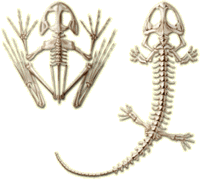 Amphibian and Salamander skulls. (Source: Canada's Aquatic Environment)
Amphibian and Salamander skulls. (Source: Canada's Aquatic Environment) The skeleton of [[amphibian]s] has both bony and cartilaginous components in different ratios, depending on the strength required for locomotion.
Salamanders have a largely cartilaginous skeleton, while that of frogs is more rigid and bony to withstand the impact of jumping and landing. Caecilians have dense, rigid skulls for burrowing through hard sediments, but they have lost all components of the appendicular skeleton.
Amphibian lungs are paired and they have a 3-chambered heart, unlike mammals, which have 4-chambered hearts.
Digestion occurs in the stomach and wastes are expelled through a cloaca which is also part of the reproductive system of females.
Senses
Amphibians are very susceptible to temperature and pressure change, and their highly permeable skins makes them particularly vulnerable to poisons in their environment. Their sensitive nervous and "lateral line" systems are designed to detect these threats.
Sight is of varied importance to [[amphibian]s] depending on their habitat. In many species, sight is well developed for hunting. However, in others that live in almost complete darkness, like caecilians, eyes have been lost or have become greatly reduced.
Most amphibians are nocturnal and hunt in low light conditions. There are some general rules which relate pupil shape to vision type. For example, the "Kermit-like" vertical, slit-shaped pupil is an indication of excellent night vision, whereas rounder pupils tend to indicate better vision in daylight.
Amphibians have an ear structure which is similar to that of other vertebrates, but with a twist. Airborne sounds are heard in the same way, however a second unique pathway "hears" seismic vibrations through the amphibians front feet! As you rush to catch a frog, its jump to freedom may well be provoked by the rumbling vibrations of your footsteps.
Reproduction
[[Amphibian]s] accomplish fertilization of their eggs in a variety of ways. External fertilization, employed by most frogs and toads, involves a male holding a female in a pose called amplexus. In amplexus, the male releases sperm over the female's eggs as they are laid. Less risky is the method employed by many salamanders whereby the male deposits a packet of sperm called a spermatophore onto the ground. The female then pulls it into her cloaca where fertilization occurs internally. By contrast, caecilians and tailed frogs use internal fertilization just like reptiles, birds and mammals. The male deposits sperm directly into the female's cloaca via an intromittent organ.
Most amphibians lay their eggs in water and then abandon them to their fates, but a few have developed strange ways to guard their eggs until they have hatched. The Surinam toad (Pipa pipa) of South America carries its eggs in pockets of skin on its back until the froglets hatch three months later. The gastric brooder (Rheobatrachus silus) of Australia no sooner lays its eggs than it swallows them! The eggs incubate in the frog's stomach where acid production ceases until the froglets hatch and crawl out through their mother's mouth.
In most cases, amphibian eggs hatch into free-living aquatic larvae which later metamorphose into juveniles in what may seem like a greatly accelerated re-enactment of amphibian evolution.
Frog and toad tadpoles are mostly herbivorous, having filter feeding mouthparts and long digestive tracts. They breathe through gills and have long swimming tails, but no limbs. During metamorphosis, their mouths widen, their guts shorten, and lungs form inside their growing chest cavities. Small legs appear on both sides of their diminished tails. Finally, forelimbs erupt from what had been the gill chambers and the froglets emerge onto land, sometimes in impressive numbers.
